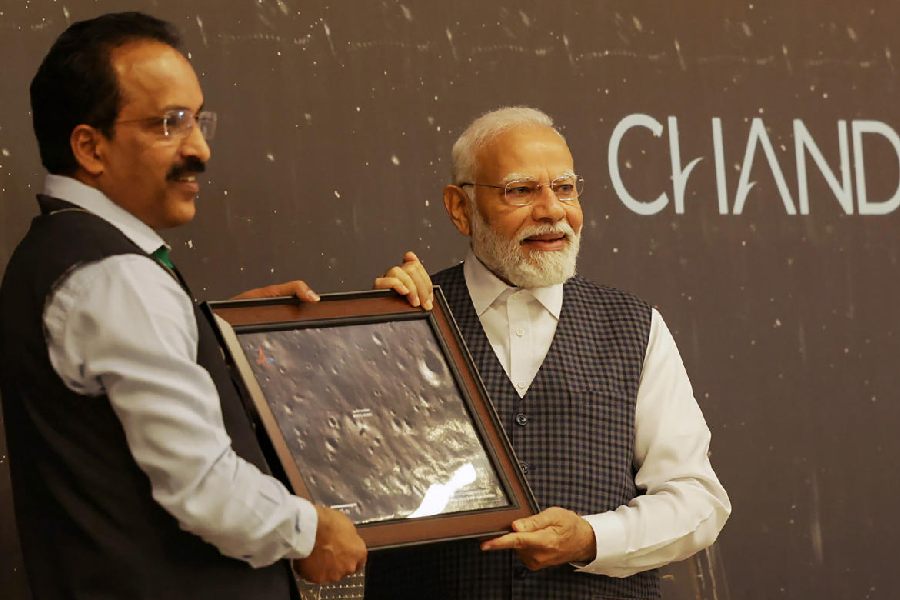In the planetary gazetteer, Lakshmi has beaten Shiv Shakti by at least 44 years.
Prime Minister Narendra Modi announced on Saturday that the Chandrayaan-3 lander’s touchdown point would be named Shiv Shakti.
“India has decided to name the site where Chandrayaan landed. The point where the Chandrayaan-3 lander landed will now be known as Shiv Shakti,” Modi told engineers and scientists at the Indian Space Research Organisation (Isro) in Bangalore.
The Shiv Shakti point provides a sense of connectedness from the Himalayas to Kanyakumari, Modi said. “The Shiv Shakti point will inspire future generations to use science for the welfare of humanity,” the Prime Minister said.
He announced Tiranga as the name for the site where Chandrayaan-2 has left its imprints on the moon.
Chandrayaan-2 had crashed into the moon in September 2019. The Tricolour gives the strength to fight every crisis, the Tricolour gives the inspiration to make every dream come true, Modi said, adding that the Tricolour served as the inspiration for Chandrayaan-3’s success after Chandrayaan-2’s failure.
Astronomers familiar with how geographic features and other sites on planetary bodies, including the moon, get their names said a group of experts under the International Astronomical Union (IAU) had the authority to assign nomenclature.
“Under the IAU rules, for a name to be globally accepted, it must follow certain criteria. However, that doesn’t prevent any country from giving different names in local languages,” said a senior astronomer in a central government institution in Mumbai. “These names (Shiv Shakti and Tiranga) may be used within India but need not be recognised for international communications,” the astronomer said.
The planetary gazetteer, maintained by the US Geological Survey, adopts names
approved by the IAU nomenclature group and represents the diversity of human cultures — with gods and goddesses from across the world, characters from literature, including Shakespeare, the Arabian Nights, and Homer’s Odyssey, as well as deceased people, terrestrial villages, heroes and heroines from myths.
The nomenclature follows certain criteria or protocols. For instance, many features on Venus are named after goddesses from different cultures. In 1979, the IAU panel approved Lakshmi Planum, a distinctive plateau marked by two volcanoes and surrounded by bands of mountains.
Some features on Mercury, for instance, are named after abandoned cities or settlements from Earth’s antiquity, while craters on Jupiter’s moon Europa are named after Celtic gods and heroes, and Saturn’s moon Enceladus has features named after people and places in the Arabian Nights.
“The names proposed (on Saturday) are a deviation from the standard criteria adopted for lunar nomenclature,” said another physicist in a central institution. All scientists cited in this report requested anonymity.
Some scientists said they were not surprised by the proposed names as they appeared to reflect a heady mix of nationalism and power, drawing on imagery from the Hindu religion.
“The names have a political content with a direct appeal to the part of the electorate firmly behind the ruling dispensation,” said a professor of physics in a central educational institution.
“It plays up to the rampant narrative that India has always been a weak nation and has finally discovered aggression and found its place in the global scenario,” the academic said.
“The fact that we have taken firm steps over the past 75 years is blissfully ignored,” the professor added.
The Indian National Science Academy is the official body in India assigned to
communicate with the IAU group involved in nomenclature, another astronomer said. “India will need to officially suggest these names to the group to get them to be accepted,” the astronomer said.
The same will apply to the site where the Chandrayaan-1 orbiter’s moon impactor — an instrument hurled onto the moon from the orbiter — had hit the lunar surface. “The late President A.P.J. Abdul Kalam had named it Jawaharsthal, the astronomer said, adding that he does not know whether international recognition of the name had been applied for and whether it had been granted.
“I think the names of Dhawan or U.R. Rao would have been appropriate,” an astronomer said. Satish Dhawan laid critical foundations of policy directions and technology development that helped turn India, a developing country, into a spacefaring nation. The late Rao was another head of the space agency.
Features on the moon have typically been named after famous deceased scientists, scholars, artists, or named after the weather or the states of mind — such as the Sea of Tranquility, the area chosen for the Apollo 11 landing in 1969 with the landing site itself called Tranquility Base.
The Chandrayaan-3 landing site itself is a strip of flat land close to the Boguslawski crater, an impact crater named after the 19th-century German astronomer Palon Heinrich Ludwig Boguslawski.










